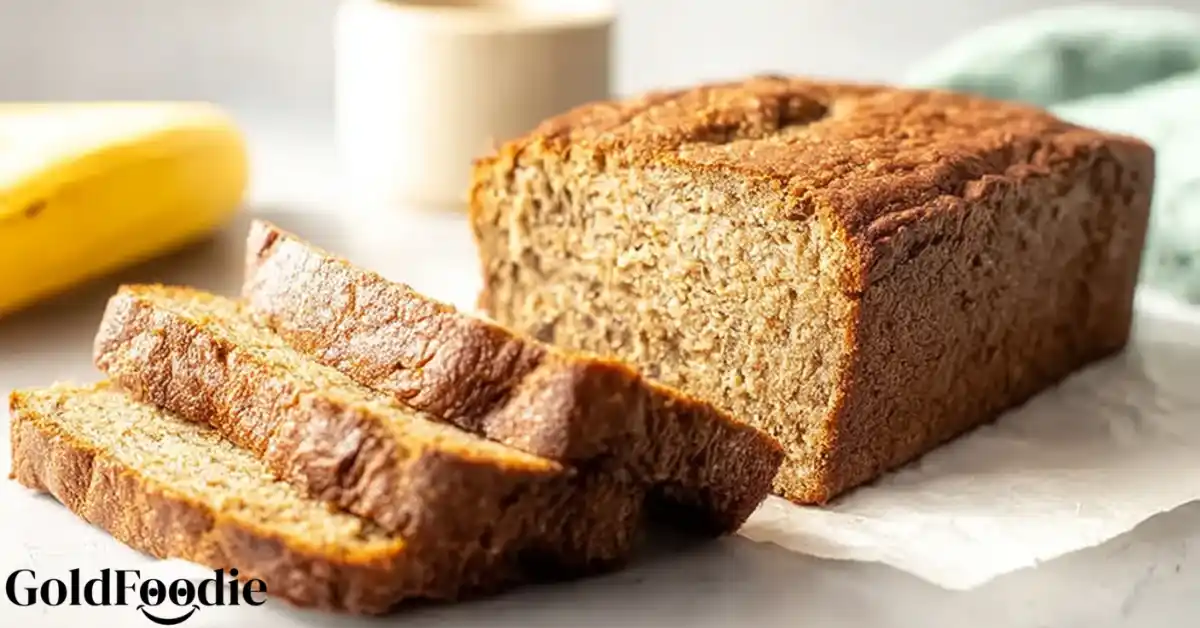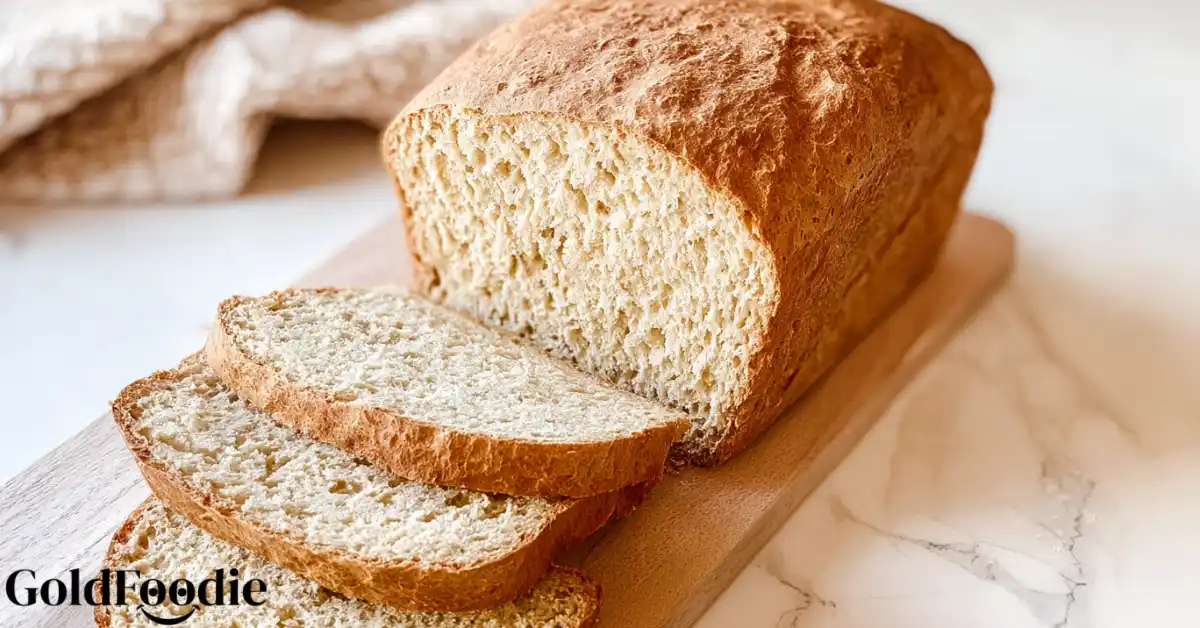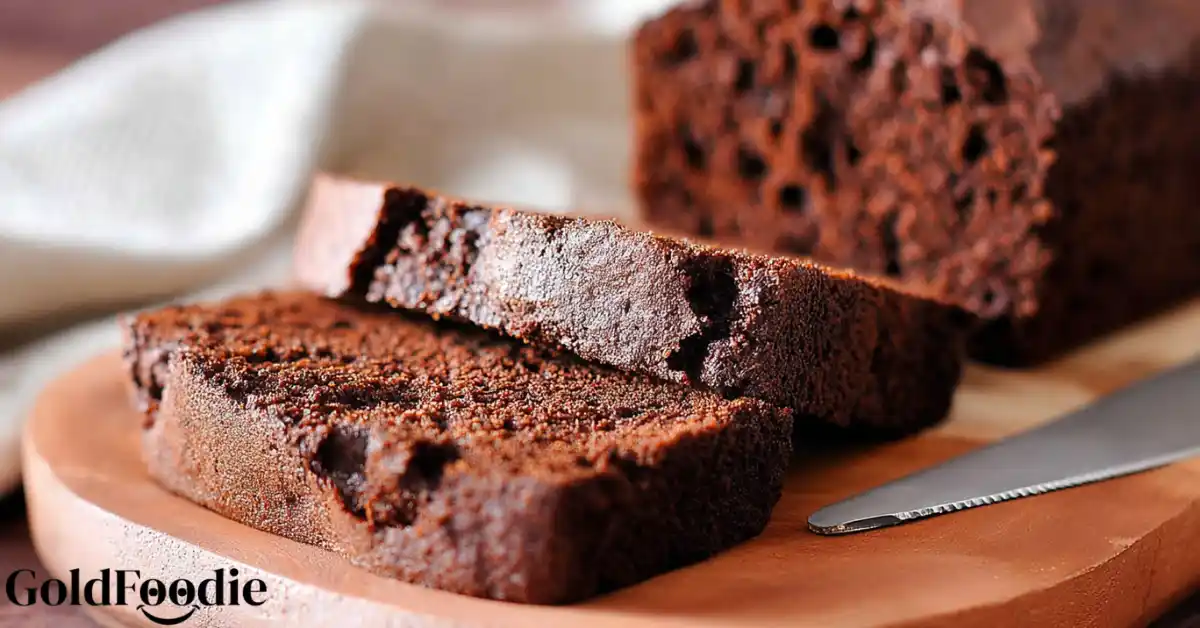Looking for a bread that’s hearty, healthy, and fits nearly every diet? This sunflower seed flour bread is your new go-to loaf.
Imagine a loaf of bread that’s soft inside, golden on the outside, and full of rich, nutty flavor without any nuts. That’s the magic of sunflower seed flour bread. It’s not just homemade and satisfying, but naturally gluten-free, nut-free, and perfect for anyone following a keto or vegan lifestyle.
Whether you’re managing dietary needs, cutting carbs, or simply exploring healthier options, this sunflower seed flour bread has you covered. It’s packed with protein, fiber, and flavor, making it a smart choice for daily meals or special diets.
In this guide, you’ll get everything you need to bake the perfect loaf. From making your own sunflower seed flour to solving the mystery of green bread, you’ll also find tested recipe variations, a full troubleshooting section, and essential baking tips. This isn’t just a recipe it’s your go-to resource for making sunflower seed flour bread the right way, every time.
Table of Contents
What is Sunflower Seed Flour? (And How to Make It)
Sunflower seed flour is simply finely ground raw, unsalted sunflower seeds. It’s a naturally gluten-free, nut-free alternative that works beautifully in bread recipes. You don’t need anything fancy to make it, just a blender or food processor and the right technique.
How to Make Sunflower Seed Flour at Home
- Start with raw, unsalted sunflower seeds. Avoid roasted or salted seeds. They can make your bread oily and alter the flavor.
- Use a food processor or high-speed blender. Add the sunflower seeds in small batches for better control and even grinding.
- Pulse the seeds in short bursts. This step is key. Blending too long can turn the seeds into sunflower seed butter instead of flour.
- Check the texture. The goal is a fine, powdery consistency that looks similar to almond flour or coconut flour.
Making your own sunflower seed flour not only saves money but also gives you full control over freshness and quality. It’s the first and most important step in creating delicious sunflower seed flour bread at home.
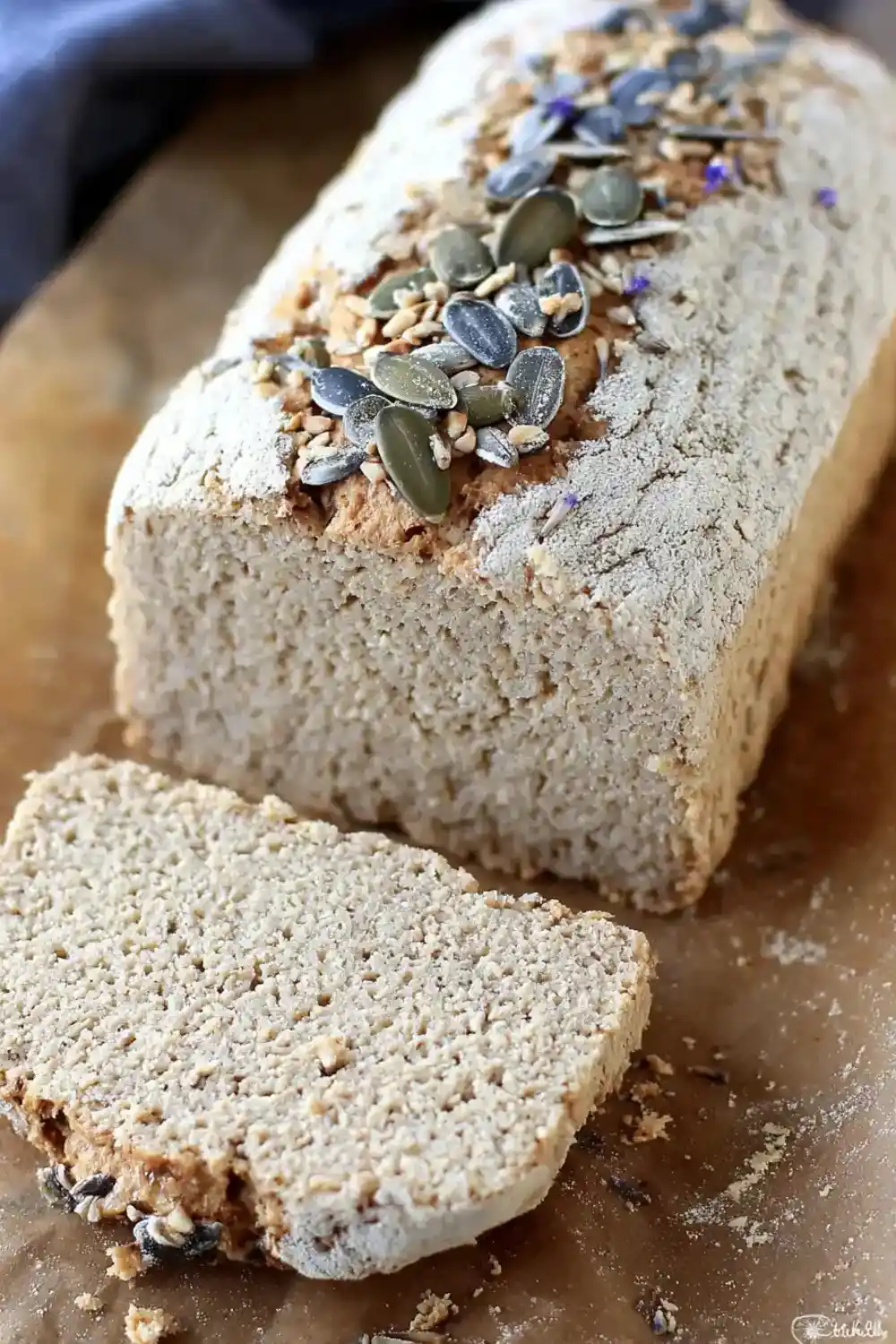
⭐️⭐️⭐️⭐️⭐️
“Sunflower seed flour contains extremely high protein about 40 % to 66 % plus fiber, iron, calcium, and chlorogenic acid, which offer antioxidant, anti‑inflammatory and blood sugar‑modulating benefits.” Leonardo Mendes de Souza Mesquita, Institute of Biosciences, University of São Paulo
You’ll Also Love
➤ Zucchini bread
➤ Sprouted Grain Bread Soft Nutty Delicious Homemade
➤ Low-Carb Bread Soft Gluten-Free Loaf Recipe
The Science: Why Sunflower Seed Flour Bread Turns Green (And How to Fix It)
First, don’t panic. If your sunflower seed flour bread comes out of the oven with a green tint, it’s not spoiled or unsafe to eat. The green color is actually a harmless reaction caused by a natural antioxidant found in sunflower seeds called chlorogenic acid.
When chlorogenic acid reacts with alkaline ingredients like baking soda, it can turn the inside of your bread green. This often happens after baking as the bread cools. It’s a common surprise for first-time bakers using sunflower seed flour.
How to Prevent Green Sunflower Seed Flour Bread
- Add a mild acid. Lemon juice or apple cider vinegar helps balance the pH level of the batter. For this recipe, use one tablespoon of apple cider vinegar. It keeps the bread light in color and enhances the rise.
- Use baking powder instead of baking soda. Baking powder contains its own acid, typically cream of tartar, which helps avoid the green reaction entirely.
This recipe is already adjusted to avoid the green tint, so you’ll get all the benefits of sunflower seed flour bread without any surprises.
Ingredients Needed for Sunflower Seed Flour Bread
To make a healthy and reliable loaf of sunflower seed flour bread, use simple whole-food ingredients. These items are easy to find and work well for gluten-free, vegan, and keto-friendly variations.
Dry Ingredients
• 225 grams or about one and a half cups of raw sunflower seeds (used to make the flour)
• 225 grams or two cups of gluten-free flour blend (you can use plain flour if gluten is not a concern)
• Three heaped teaspoons of gluten-free baking powder
• One quarter teaspoon of baking soda
• One quarter teaspoon of salt
Wet Ingredients
• One and a half cups or 345 milliliters of unsweetened almond milk (or your favorite plant-based milk)
• One tablespoon of apple cider vinegar
Optional Topping
• A handful of mixed seeds for decoration
These ingredients come together to form a sturdy, moist, and flavorful base. The combination of sunflower seed flour with plant-based milk and vinegar gives this bread its ideal texture and subtle nutty taste.
How to Make Sunflower Seed Flour Bread
Follow these clear and detailed steps to create your own loaf of sunflower seed flour bread at home. Each step is simple, and the results are well worth it.
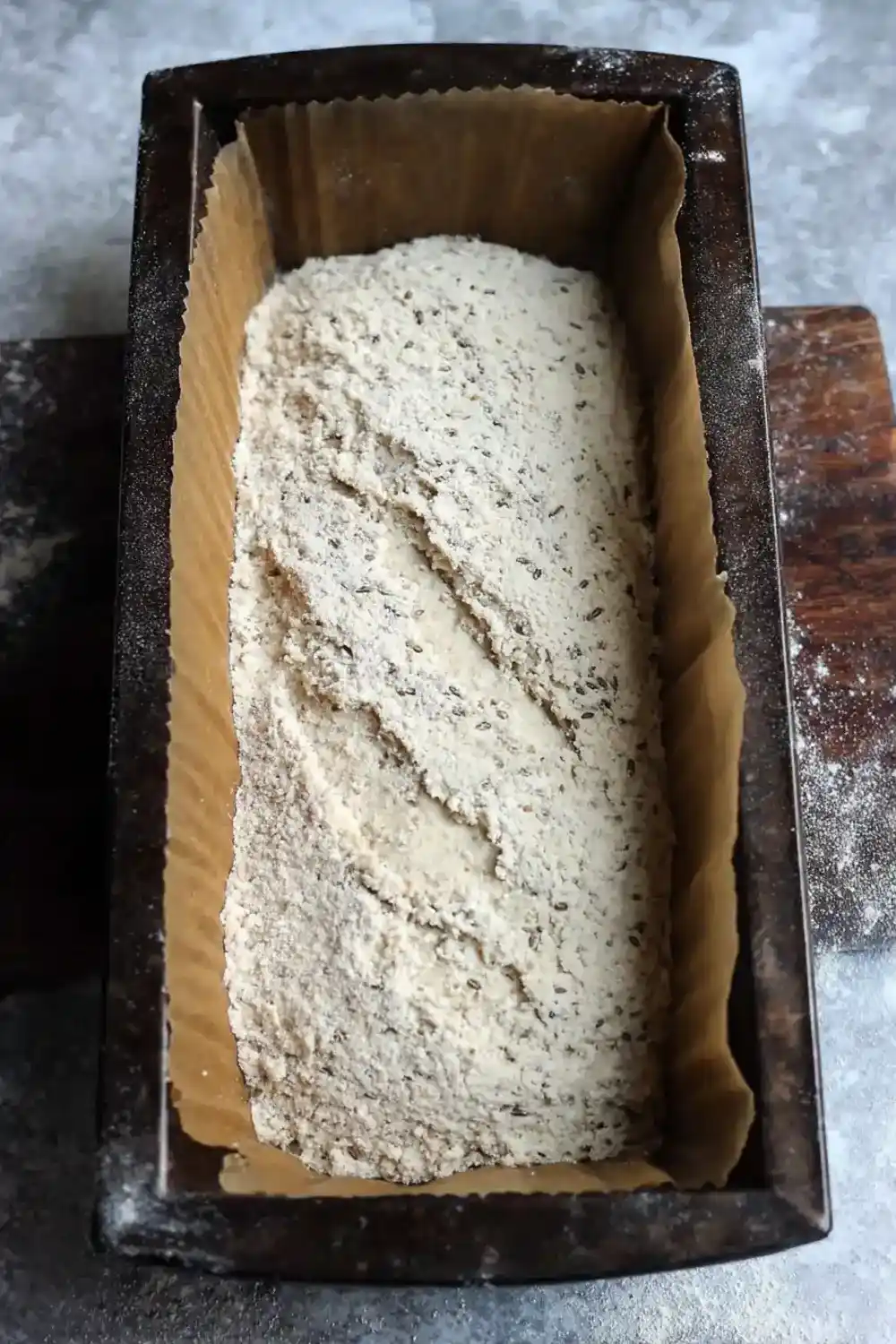
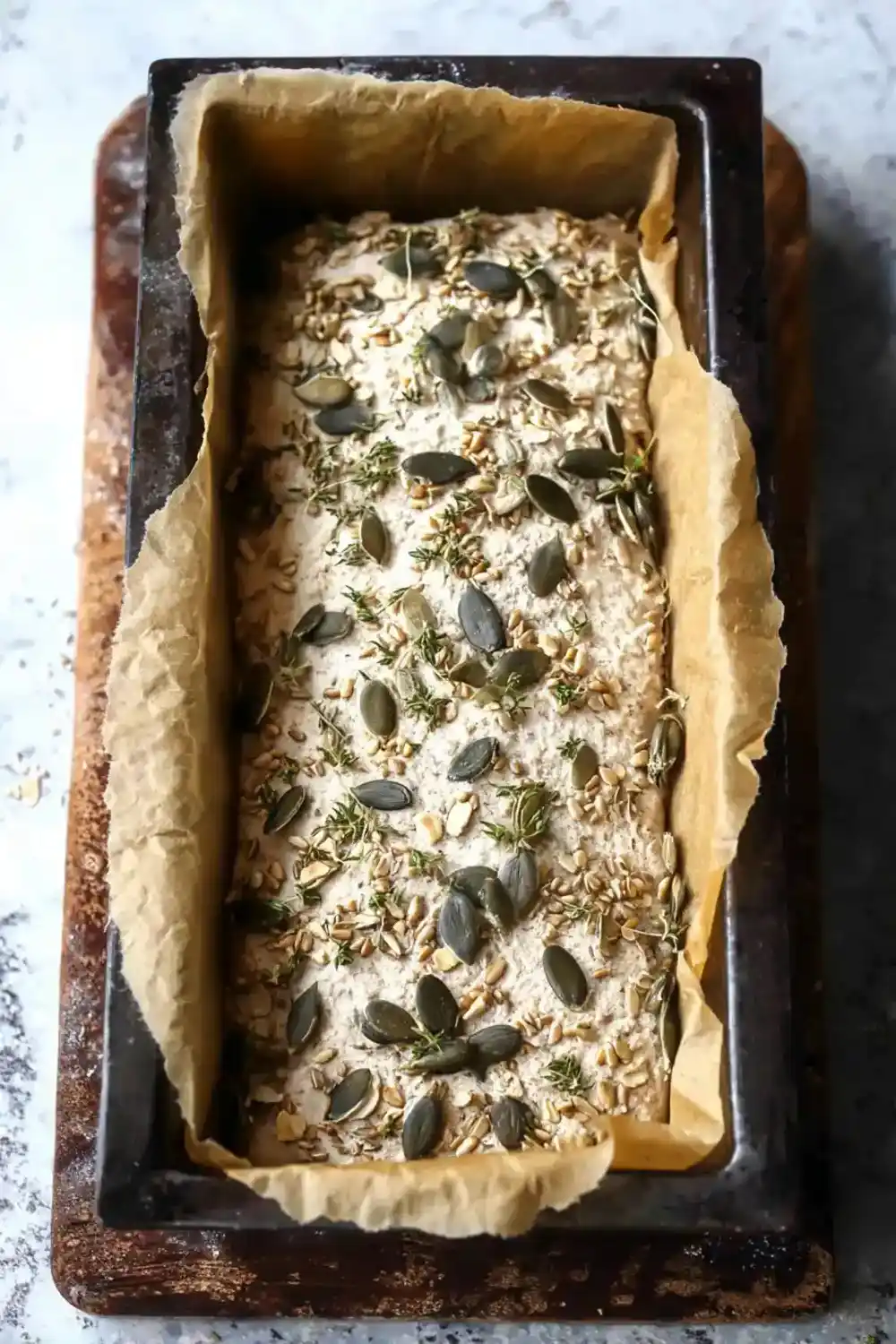
- Preheat your oven. Set it to 180 degrees Celsius or 350 degrees Fahrenheit. This ensures the oven is hot and ready by the time your batter is prepared.
- Grind the sunflower seeds. Place the raw, unsalted sunflower seeds into a food processor or high-speed blender. Pulse in short bursts until you get a fine, flour-like texture. Avoid over-blending to prevent making sunflower seed butter.
- Mix the dry ingredients. Transfer the ground sunflower seed flour into a large mixing bowl. Add the gluten-free flour blend, baking powder, baking soda, and salt. Stir everything until evenly combined.
- Add the wet ingredients. Pour in the almond milk and apple cider vinegar. Stir well until a smooth batter forms. The mixture will be thick but spreadable.
- Prepare the baking tin. Line a standard one-pound loaf tin with parchment paper and lightly grease it. Spoon the batter into the tin and smooth out the top.
- Add optional toppings. Sprinkle a mix of seeds across the surface for extra crunch and visual appeal.
- Bake the bread. Place the loaf tin in the center of the oven. Bake for about 55 minutes or until a skewer inserted into the center comes out clean.
- Cool completely. Remove the bread from the oven and let it rest in the tin for ten minutes. Then transfer it to a wire rack to cool fully before slicing.
This process gives you a consistent and moist sunflower seed flour bread with a golden crust and tender inside. Cooling the loaf is key for the best texture and clean slices.
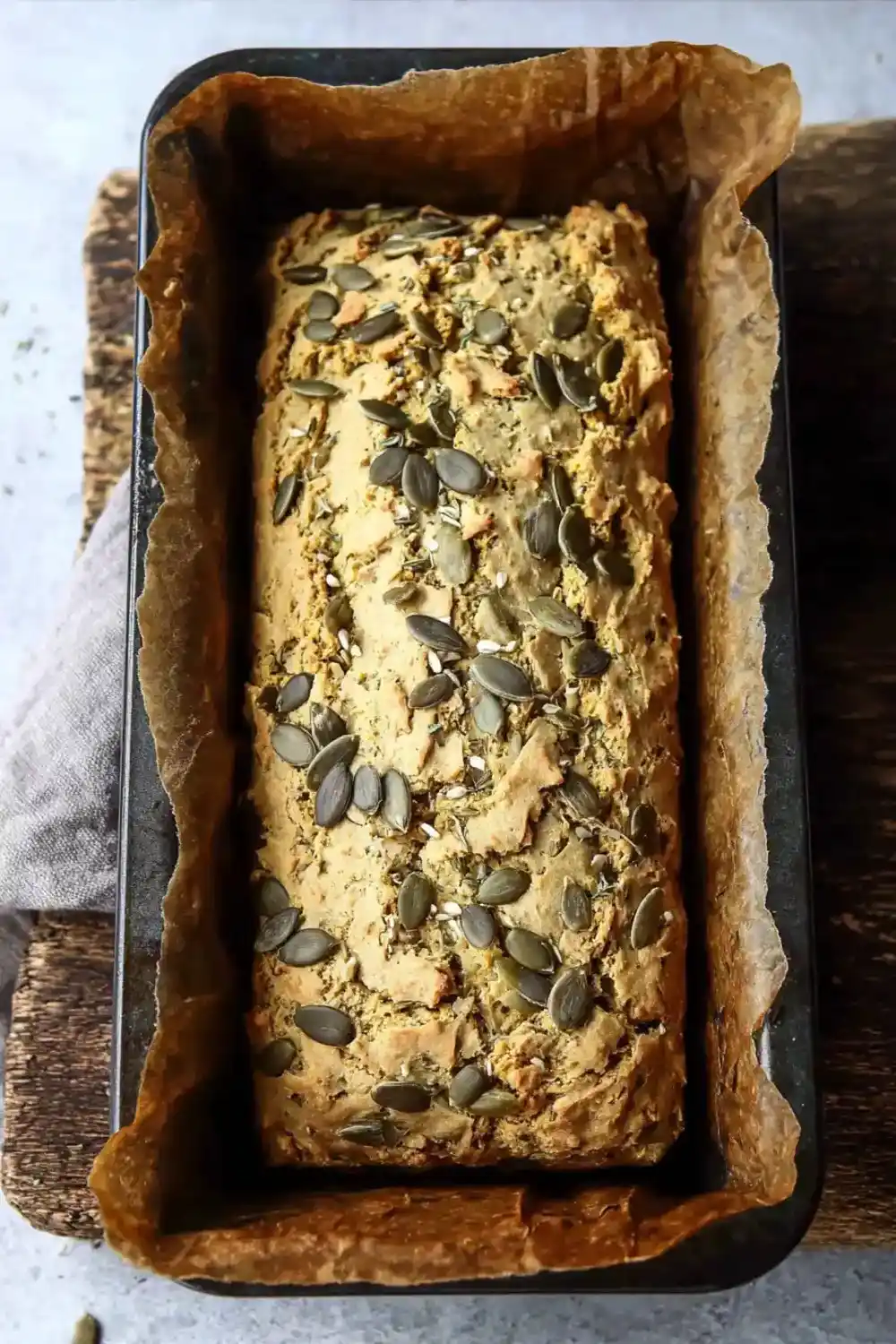
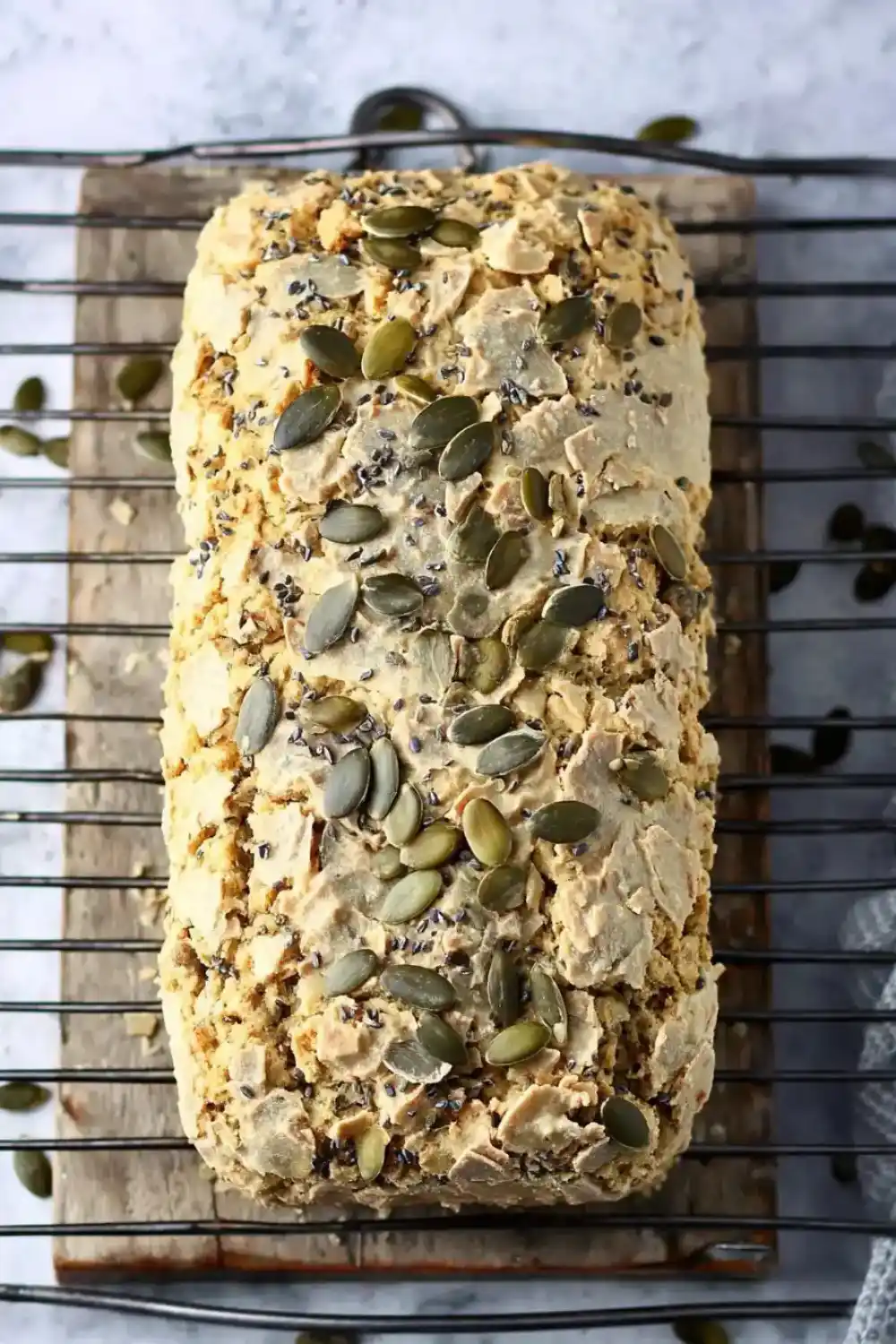
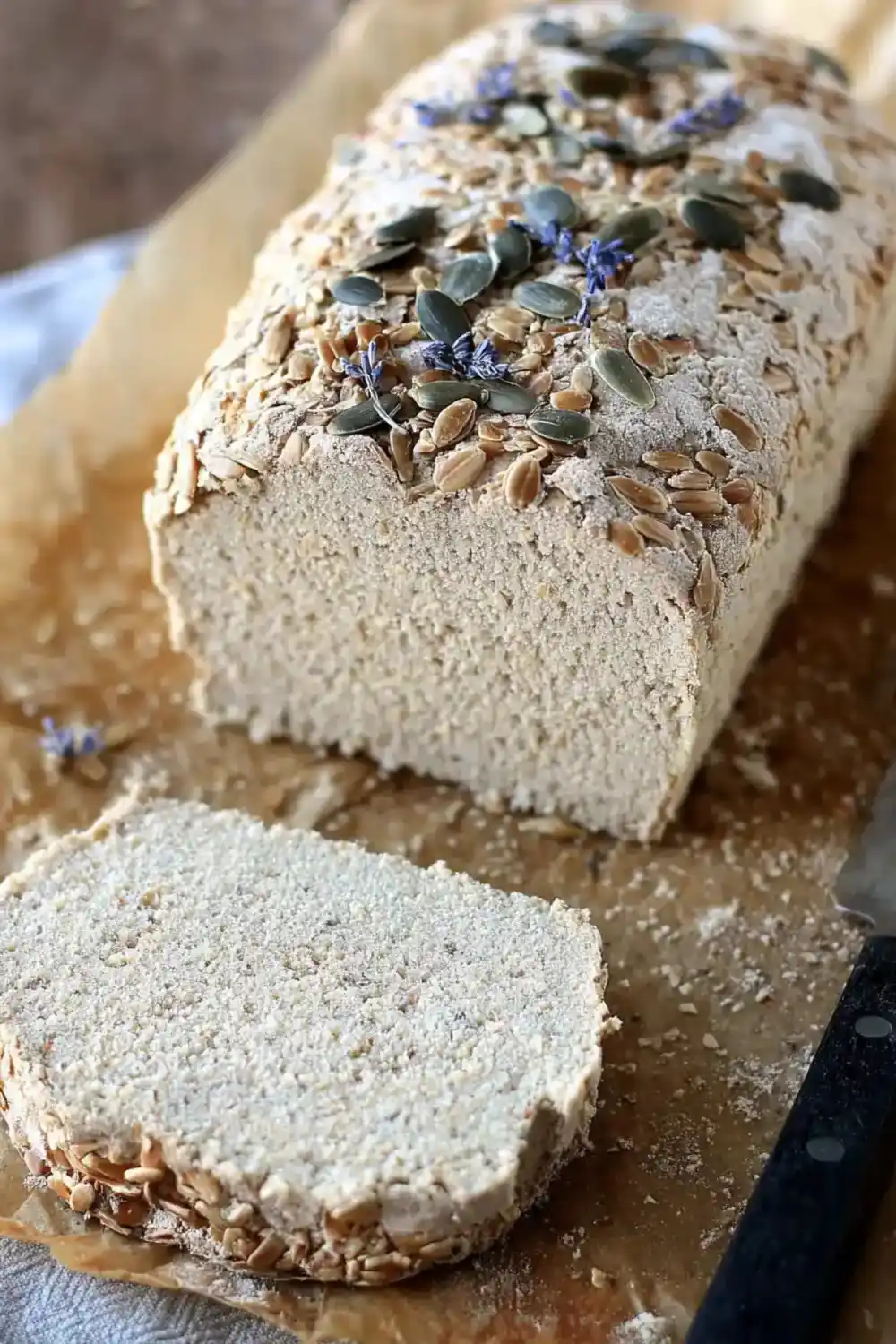
Sunflower Seed Flour Bread
Ingredients
Method
- Preheat your oven to 180°C (350°F) to ensure it’s ready for baking.
- Grind the sunflower seeds in a food processor or high-speed blender using short pulses until a fine, flour-like texture is achieved. Avoid over-blending.
- In a large mixing bowl, combine the sunflower seed flour, gluten-free flour blend, baking powder, baking soda, and salt. Stir to combine.
- Add the almond milk and apple cider vinegar to the dry ingredients. Mix well until you have a thick, smooth batter.
- Line a one-pound loaf tin with parchment paper and lightly grease it. Spoon the batter into the tin and smooth the top.
- Sprinkle mixed seeds over the top of the batter for added crunch and visual appeal.
- Bake in the preheated oven for about 55 minutes or until a skewer inserted in the center comes out clean.
- Let the bread cool in the tin for 10 minutes, then transfer to a wire rack to cool completely before slicing.
Notes
Nutrition Facts (Per Serving)
Calories: 169 | Calories from Fat: 99 | Total Fat: 11 g | Saturated Fat: 1 g | Sodium: 111 mg | Potassium: 146 mg | Total Carbohydrates: 16 g | Dietary Fiber: 3 g | Total Sugars: 1 g | Protein: 6 g | Vitamin A: 10 IU | Vitamin C: 0.2 mg | Calcium: 71 mg | Iron: 1.6 mgCritical Baker’s Tips for Guaranteed Success with Sunflower Seed Flour Bread
Making sunflower seed flour bread is easy once you know the small but important details. These tips will help you avoid common mistakes and get the best possible texture and flavor in every loaf.
Use a kitchen scale
Measuring your ingredients by weight gives you consistent results. Flours can vary a lot in volume when measured by cups, so weighing ensures accuracy.
Do not over-blend sunflower seeds
When grinding sunflower seeds, pulse in short bursts. Blending too long turns them into sunflower butter, which changes the recipe entirely and can make the bread dense and oily.
Always cool completely before slicing
Let the bread sit on a wire rack until it’s fully cool. Cutting it while warm can lead to a gummy center and uneven slices.
Check for doneness properly
Insert a skewer into the center of the loaf. It should come out clean. For extra accuracy, use a food thermometer. The internal temperature should reach about 93°C or 200°F.
Following these tips gives your sunflower seed flour bread the best structure, flavor, and shelf life every time you bake.
Tested Recipe Variations for Sunflower Seed Flour Bread
Once you’ve mastered the basic loaf, try these tested variations of sunflower seed flour bread. Each one is designed for specific dietary needs or flavor preferences and includes exact ingredients for reliable results.
Keto Sunflower Bread
To lower the carb count, replace the gluten-free flour with almond flour or a low-carb baking blend. Use unsweetened almond milk and check that your baking powder is carb-free.
Net carbs per slice: About 3 grams, depending on serving size and ingredients used.
Vegan Sunflower Bread (Egg-Free)
If you’re avoiding eggs, use a flaxseed meal substitute. Combine one tablespoon of ground flaxseed with three tablespoons of water. Let it sit for ten minutes before adding it to the batter. This mix replaces one egg.
Savory Herb and Garlic Variation
Add one teaspoon of garlic powder, one teaspoon of dried rosemary, and half a teaspoon of thyme to the dry ingredients. These herbs give the sunflower seed flour bread a warm, savory flavor perfect for pairing with soup or salad.
Sweet Cinnamon Raisin Option
Mix one and a half teaspoons of cinnamon, two tablespoons of a keto-friendly sweetener, and one-third cup of raisins or dried cranberries into the batter. This version works well as a breakfast bread or afternoon snack.
These options give your sunflower seed flour bread a fresh twist while keeping it wholesome and easy to prepare.
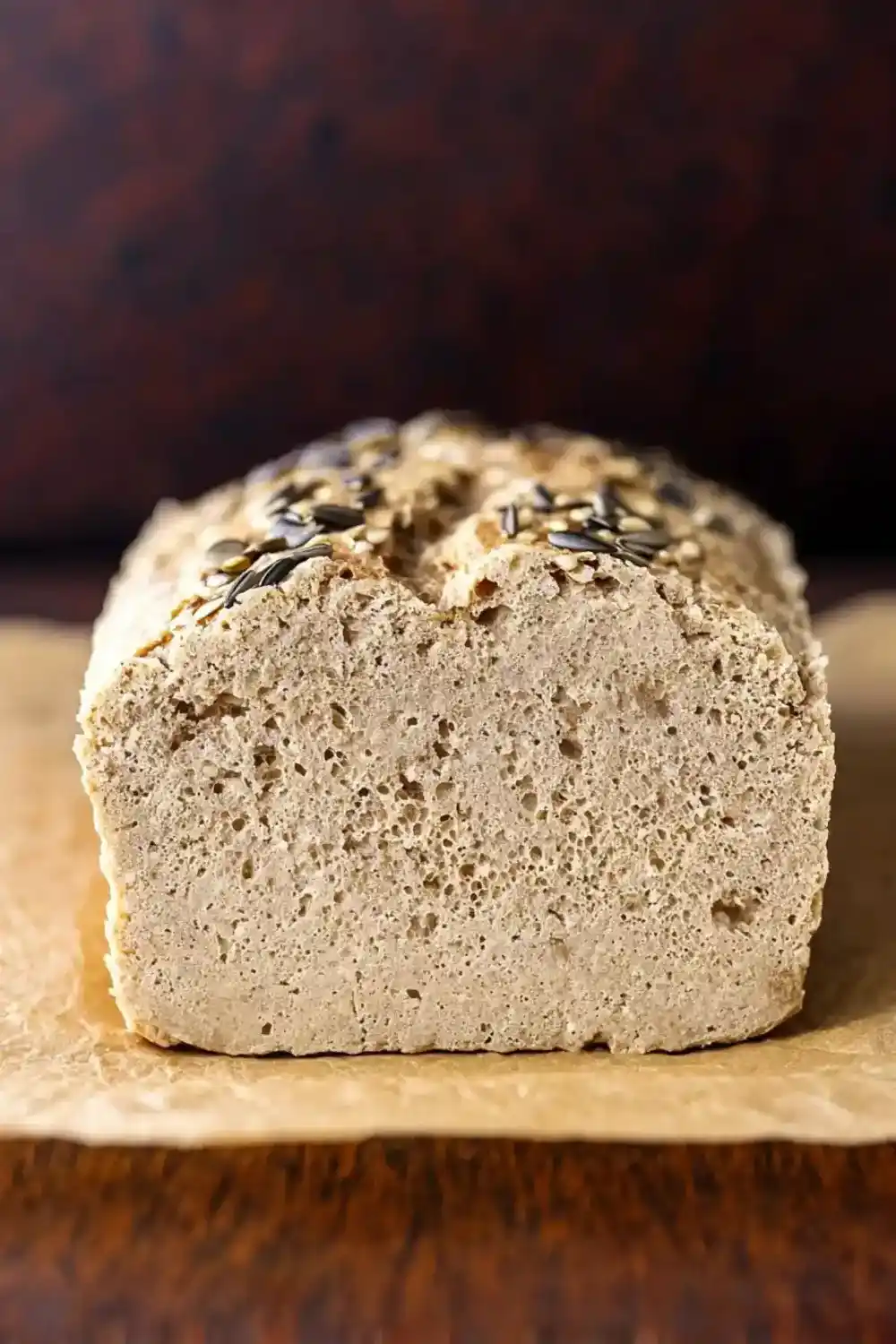
Troubleshooting for Sunflower Seed Flour Bread
Even experienced bakers run into issues now and then. This section answers common questions and helps you fix problems quickly so your sunflower seed flour bread turns out great every time.
Why is my bread dry and crumbly?
Dry texture often comes from using too much flour or baking it too long. Always weigh your dry ingredients and avoid overbaking. If needed, add a little more almond milk next time to improve moisture.
Why is my bread dense, wet, or gummy inside?
Most often, this happens when the bread is sliced before it has cooled completely. Another cause could be underbaking. Make sure a skewer comes out clean and the loaf feels firm before removing it from the oven.
Can I use sunflower seed butter instead of grinding seeds?
You can, but the texture will be different. Sunflower seed butter adds more moisture and may make the bread heavier. It also alters the flavor slightly.
Can I use psyllium powder instead of whole husks?
If your recipe calls for whole psyllium husks, using powder will absorb more liquid. You will need to adjust the amount of water or milk. Testing is key to get the right balance and prevent dryness or gumminess.
Use these tips to avoid setbacks and create perfect sunflower seed flour bread that tastes as good as it looks.
How to Serve and Store Sunflower Seed Flour Bread
Sunflower seed flour bread is incredibly versatile and pairs well with many meals. It also stores nicely, making it a great option for weekly meal prep.
Serving Ideas
• Toast slices and spread with avocado, dairy-free butter, or almond butter
• Use for open-faced sandwiches with hummus, veggies, or eggs
• Serve alongside soups, stews, or fresh salads for a hearty bite
• Enjoy as a base for mini pizzas or breakfast toasts
Storage Instructions
At room temperature
This bread does not stay fresh for long outside the fridge. If you need to leave it out, keep it in an airtight container and eat within one day.
In the refrigerator
Place the bread in an airtight container or wrap it tightly. It stays fresh for five to seven days. Always let the loaf cool fully before storing to avoid sogginess.
In the freezer
Slice the bread before freezing so you can grab one piece at a time. Wrap slices in parchment or freezer-safe wrap. Store in a zip-top bag and freeze for up to two months. To eat, toast directly from frozen or let thaw at room temperature.
Proper storage keeps sunflower seed flour bread fresh, soft, and ready to enjoy anytime.
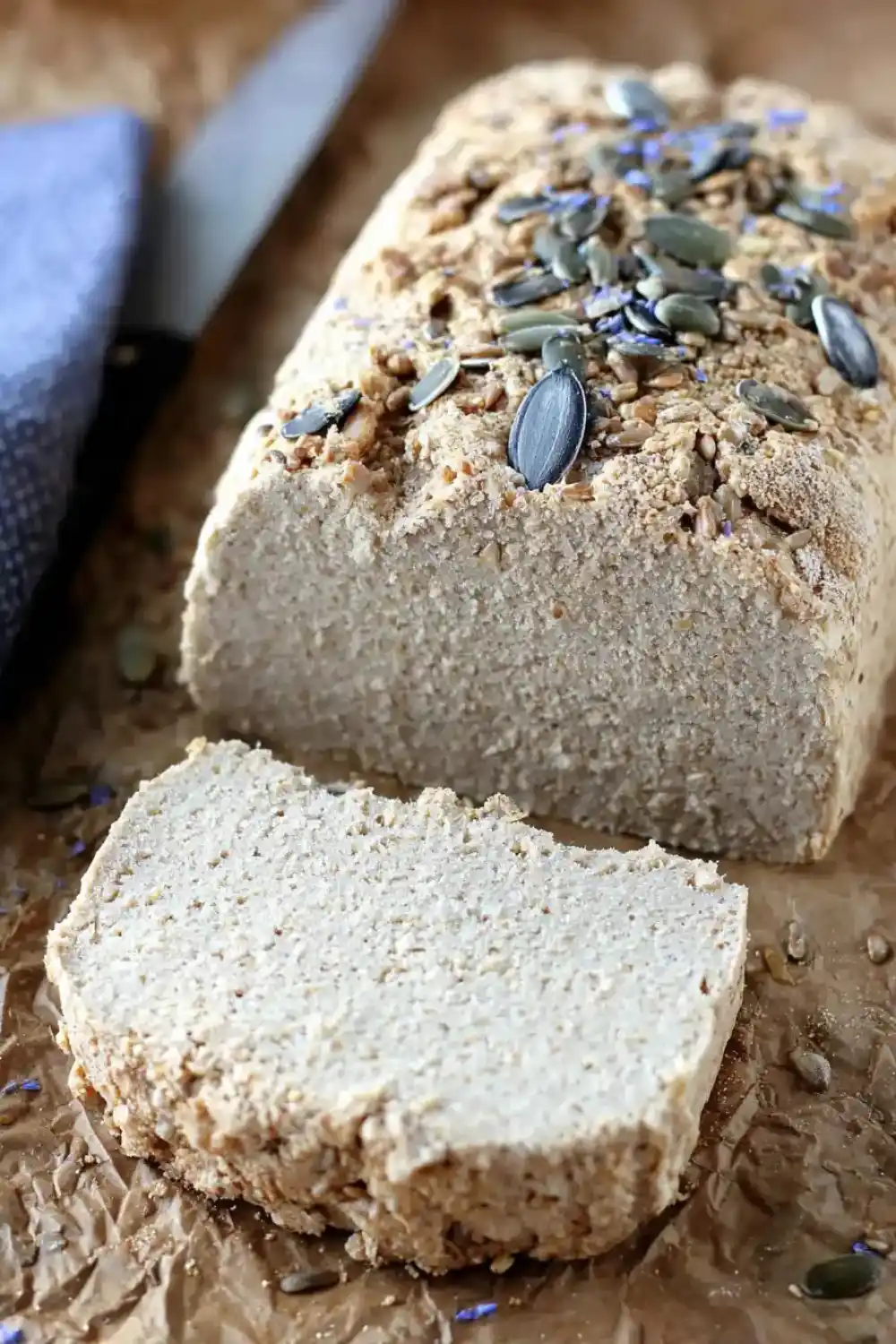
Helpful Notes for Baking Sunflower Seed Flour Bread
These extra tips will help you avoid issues and improve your baking results with sunflower seed flour bread.
Cover if browning too fast
If the top starts to brown too quickly but the center is still raw, lightly cover the loaf with parchment paper. Continue baking until a skewer comes out clean from the center.
Let it cool completely
Do not rush this step. Placing warm bread into storage traps steam and leads to soggy slices. Always cool the bread fully on a wire rack before packing it away.
Store smart for best texture
Keep the loaf covered in the refrigerator. It stays fresh for several days. If you’re not eating it the same day, toast it before serving to bring back that perfect crisp edge.
These simple steps help your sunflower seed flour bread stay soft inside, golden outside, and easy to enjoy all week.
Frequently Asked Questions (FAQ)
Is sunflower seed flour good for baking?
Yes, sunflower seed flour is excellent for baking, especially in gluten-free and nut-free recipes. It adds a rich, nutty flavor and provides good structure when used correctly.
Can you make bread with sunflower seeds?
Absolutely. You can grind raw sunflower seeds into a fine flour and use it as the base for sunflower seed flour bread. It works well in both savory and sweet variations.
Is sunflower seed bread healthy?
Sunflower seed flour bread is a healthy choice, especially for those on gluten-free, vegan, or low-carb diets. It is packed with fiber, plant-based protein, and healthy fats.
Can sunflower seeds be used in baking?
Yes, sunflower seeds can be used in many baking recipes. They can be ground into flour, added whole for texture, or used as a topping to add crunch to loaves and muffins.
Why You’ll Love This Sunflower Seed Flour Bread
Sunflower seed flour bread is more than just a healthy alternative. It’s simple to make, full of natural flavor, and fits into many dietary needs. Whether you eat gluten-free, vegan, or keto, this bread delivers a soft texture with a toasty, nutty bite that satisfies.
You can make it with everyday ingredients, grind your own flour at home, and enjoy a reliable result each time. With helpful tips, tested variations, and a full troubleshooting section, this guide gives you everything you need for success.
Tried the recipe? Leave a star rating and comment below. Share your results on Pinterest or Facebook so others can find this healthy homemade bread too. What variation did you try? Tell us how it turned out.
Diabetes Nutrition Specialist | Healthy Diet Advocate | Founder of GoldFoodie.
My passion for nutrition began with a deeply personal journey supporting my father through his battle with diabetes. Watching his daily struggles made me realize how powerful the right food choices can be in improving quality of life. That experience drove me to dedicate my career to helping others live healthier, more balanced lives.






